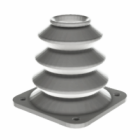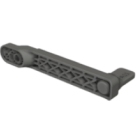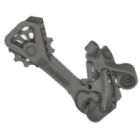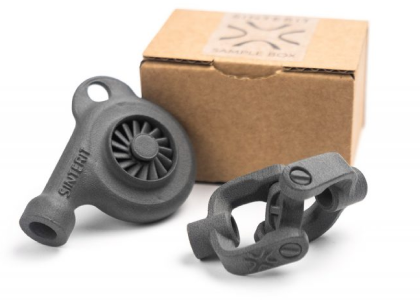3D printing of metals
3D printing of metals has transformed from a niche research method into a robust industrial solution. It enables the production of fully functional, high-performance components in materials like stainless steel, titanium, aluminum, and cobalt-chrome — without the need for molds, tooling, or subtractive machining. It’s now used across aerospace, automotive, medical, and tooling sectors to deliver strong, lightweight, and geometrically complex parts.
Can you 3D print metal?
Yes — and it’s more advanced than ever. Metal 3D printing is not a theoretical possibility; it’s an established technology already used in critical applications. Can a 3D printer print metal? Absolutely — but it requires specific hardware and materials tailored to high temperatures, controlled atmospheres, and fine powder management.
How metal 3D printing works
Metal 3D printing relies on powder bed fusion or direct energy deposition techniques. In the most common method — laser powder bed fusion (LPBF) — a thin layer of metal 3D printing powder is spread across a build plate. A high-powered laser selectively melts the powder in specific areas, layer by layer, to build the final geometry. After each layer, the platform lowers slightly and a new layer of powder is applied.
This process continues until the part is fully formed and encased in unused powder. The object then undergoes metal 3D printing sintering or post-heat treatment to relieve internal stress and improve mechanical properties.
Metal 3D printing methods
There are several main metal 3D printing technologies:
| Feature / Technology | LPBF (Laser) | EBM (Electron Beam) | DED (Direct Deposition) | Binder Jetting |
|---|---|---|---|---|
| Heat source | Laser | Electron beam | Laser or plasma arc | None (binder + furnace) |
| Material form | Powder | Powder | Powder or wire | Powder |
| Atmosphere | Inert gas (Argon) | Vacuum | Inert or open air | Ambient |
| Surface finish | Fine (high detail) | Moderate | Coarse | Fine after sintering |
| Build speed | Medium | Fast | Fast | Very fast |
| Best for | Precision parts | High-temp alloys | Large repairs or builds | Low-cost, batch parts |
| Post-processing | Precision parts | Required | Optional (machining) | Mandatory (sintering) |
3D printing metal materials
Metal 3D printers can process a wide variety of alloys, including:
- stainless steels (e.g. 316L) – corrosion-resistant and affordable,
- titanium alloys (e.g. Ti-6Al-4V) – strong, lightweight, and biocompatible,
- aluminum alloys – good strength-to-weight ratio and thermal conductivity,
- cobalt-chrome – for high wear resistance and dental/medical applications,
- tool steels – for hardened inserts, dies, and cutting tools.
Each metal for 3D printer systems is formulated as fine powder, usually between 15–45 microns in diameter, for optimal flow and fusion.
Metal 3D printing applications
Metal 3D printing is widely used in:
- aerospace – lightweight brackets, structural components, turbine parts,
- medical – patient-specific implants, orthopedic devices, dental crowns,
- automotive & motorsport – performance components, heat exchangers, housings,
- tooling – injection mold inserts with conformal cooling, jigs, fixtures,
- defense and energy – complex geometries not achievable with casting or machining.
Its biggest strength lies in producing low- to mid-volume parts with high customization, especially when weight savings or design freedom are critical.
Metal 3D printing applications
Metal 3D printing cost remains higher than polymer printing due to machine complexity, inert gas requirements, powder pricing, and post-processing. Industrial systems typically range from $200,000 to over $1M, while powders can cost $300–700 per kg. However, the return on investment is clear in applications where traditional manufacturing would require expensive tooling, long lead times, or part consolidation.
Metal 3D printer open source projects exist, but they are primarily experimental. True industrial-quality metal printing requires strict control over heat, oxygen, and precision — currently achievable only with commercial-grade machines.
How strong is 3D printed metal?
3D printed metal parts can be as strong — and in some cases stronger — than those produced through casting or machining. After heat treatment, tensile strength and fatigue performance often match wrought material standards. With proper parameter control, metal 3D printing tolerances and mechanical integrity meet the needs of critical aerospace and medical certifications.
Conclusion
3D printing of metals is no longer just an emerging technology — it’s a proven manufacturing strategy. It offers unmatched design freedom, excellent material properties, and the ability to produce complex geometries that are impossible to machine.
As metal additive manufacturing continues to mature, the question is no longer can you 3D print metal, but how will you use it to change the way things are made?
Explore also
- Polymers in 3D printing
- Biocompatible materials for 3D printing
- Raw materials for 3D printing
- Composites 3D printing
- Recycled 3D printing filament
- 3D printing flexible
- Filament types for 3D printing
- What material does a 3D printer use?
- 3D printing strongest material
- 3D printing shape memory polymer
- SLS ceramic
- SLS glass
- SLS wood
- Materials for SLS: guide
Related categories













